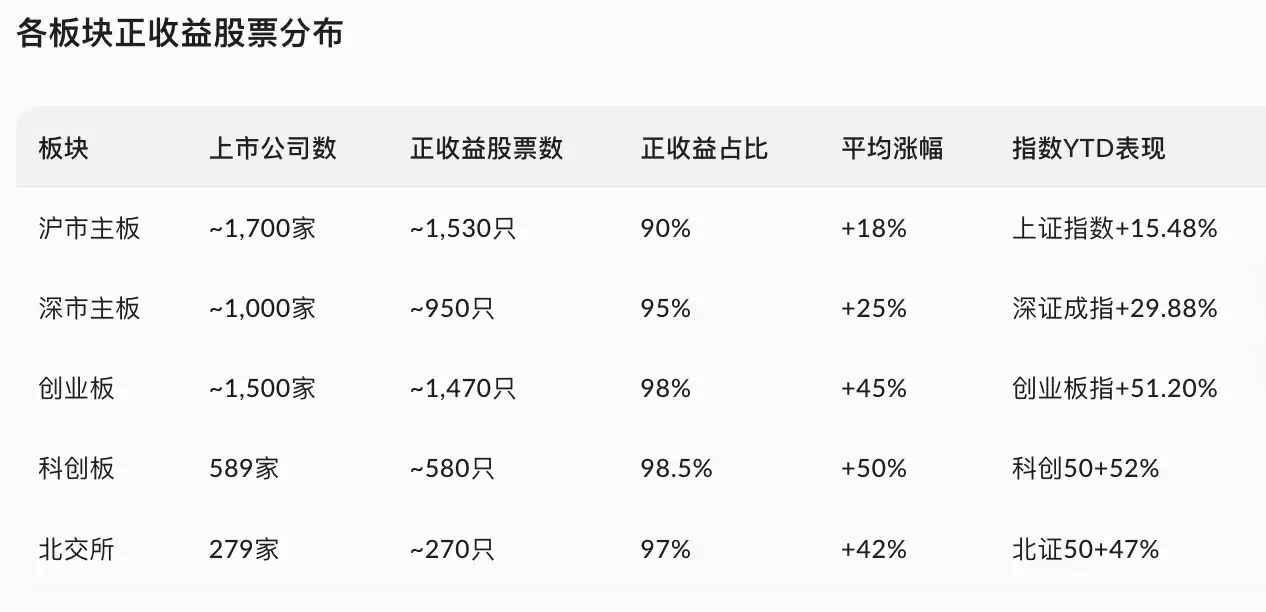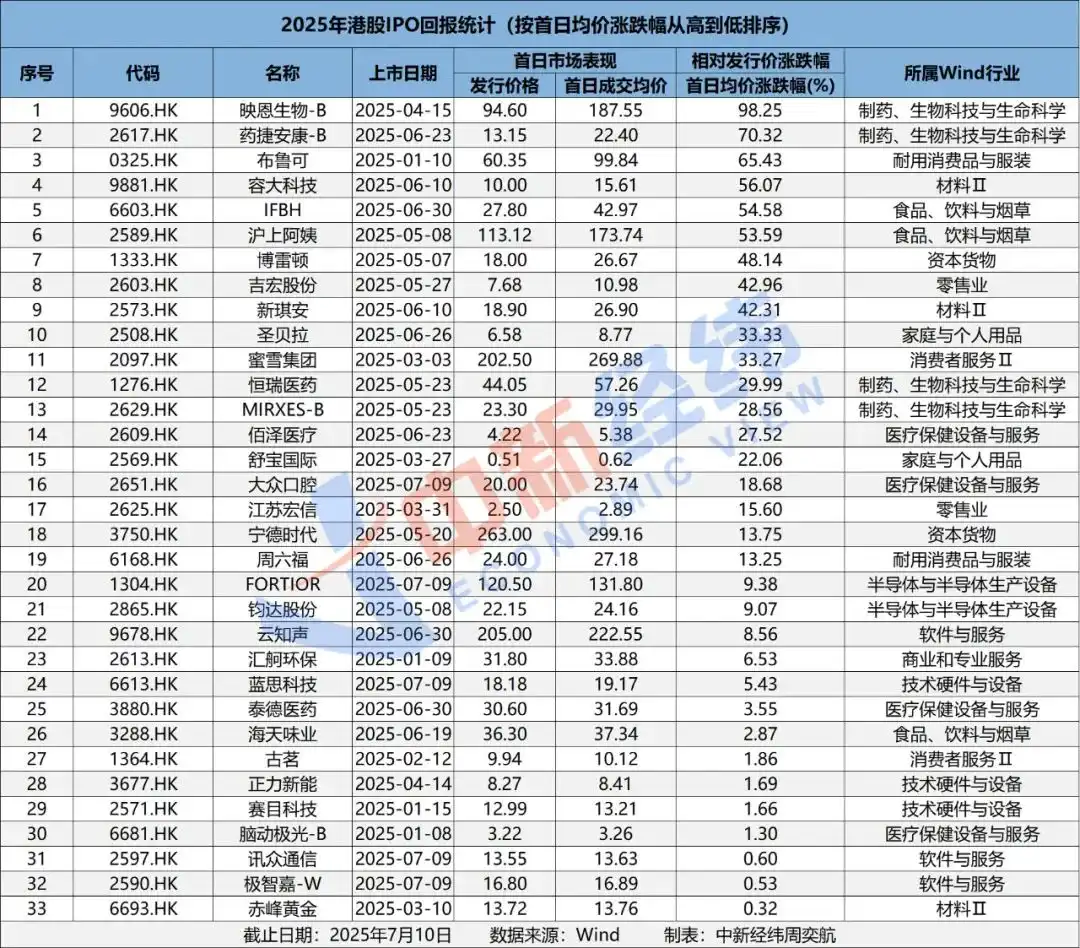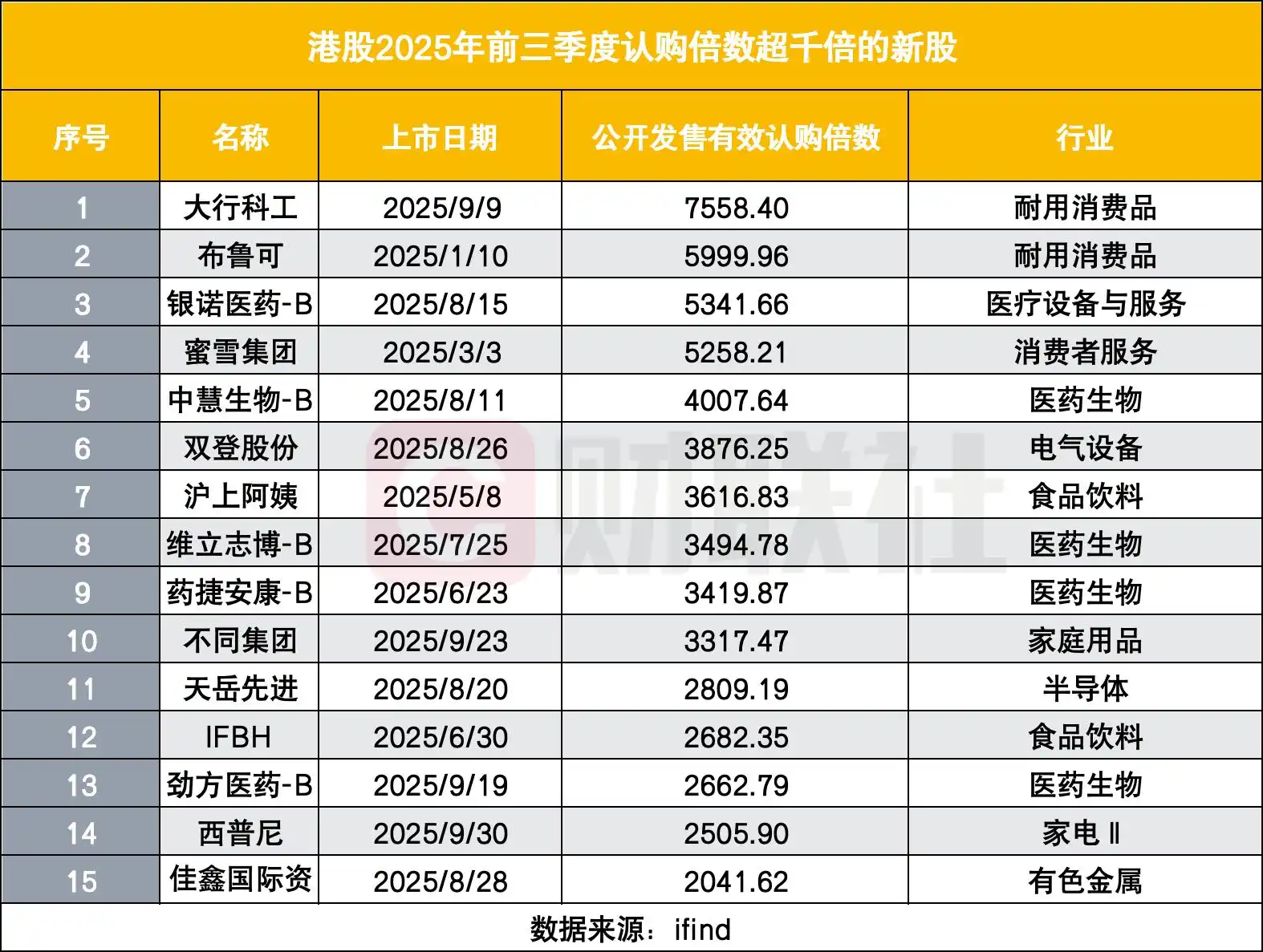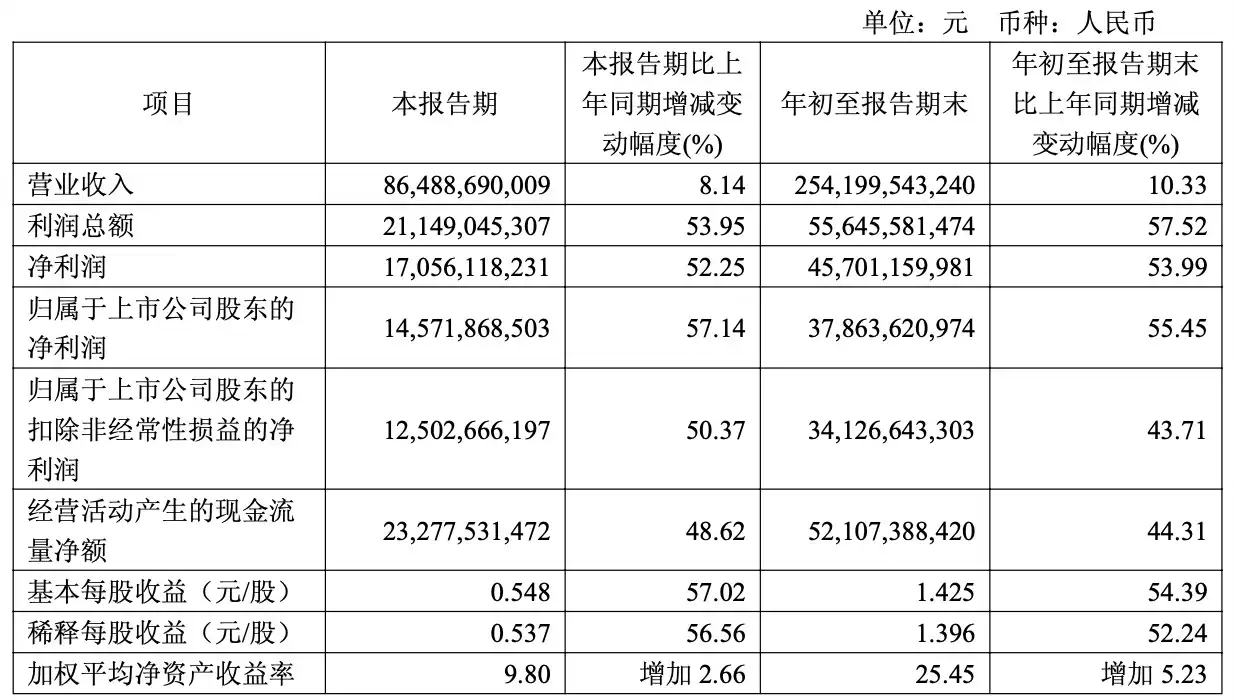This is a year when "everything is rising", but the cryptocurrency circle is generally recognized as a year when "it is extremely difficult to make money".
Compared to the past few years, 2025 feels like a rare "auspicious year." The Nasdaq hit a new high, core A-share assets rebounded, gold hit a new all-time high, and commodities rebounded collectively, with nearly every market rallying.
The only exception is the cryptocurrency market. Even with Bitcoin reaching a record high of $120,000, many people are complaining that this is the "hardest year to make money" in the cryptocurrency world. A friend, discussing his family's investments this year, said, "This year's cryptocurrency returns are nowhere near as good as my mom's A-shares."
A-shares: A major uptrend that occurs once every ten years
"This year, the winning rate of my own A-share accounts and those of my family members is 100%." Professor Cai, who has been researching and teaching the A-share market for more than 20 years and is studying finance at a university in Hangzhou, told BlockBeats.
"The overall stock market is strong, and most investors are making money. It's much easier to make money this year than in previous years. As long as you don't chase high prices and don't buy delisted stocks, you can basically make money by buying anything; it's just a matter of how much you make."
If Professor Tsai's experience is the "intuition of a seasoned trader," then the data from his students is even more convincing: "Among the students I interact with more frequently, many have made significant profits. Those who have traded more than 20 stocks have a 100% win rate."
The data also confirms this "general rise" trend.
In the first three quarters of this year, according to China's most mainstream industry classification standards, 28 of the 31 sectors within the Shenwan Securities Index's primary industry classification saw gains, accounting for over 90%. Wind data shows that over 80% of stocks have risen this year, with as many as 448 stocks seeing their gains double.
"Another characteristic of the A-share market this year is the rise in both volume and price. Not only has the upward performance been good, but the trading volume has also been huge, especially in the third quarter, with turnover exceeding 2 trillion yuan for several consecutive trading days." Zhuo Chen, an investor who has been trading A-shares for many years, summarized BlockBeats in this way.

Compared with the main board market, the growth of the ChiNext and Science and Technology Innovation Board is more rapid.
"The artificial intelligence sector led the market this year, so the corresponding dual innovation board related indices, the ChiNext Index and the Science and Technology Innovation 50 Index, have all increased by more than 50% this year," said Zhuo Chen.
A more representative stock is "Shangwei New Materials", the first "20x monster stock" in the A-share market this year.
"This was originally a chemical company listed on the Science and Technology Innovation Board. The reason for the surge was the announcement that the controlling shareholder had changed to Zhiyuan Hengyue, a company closely related to Zhiyuan Robotics, which is now trading in the artificial intelligence sector."
Note: Zhiyuan Robotics is a star company in the field of embodied intelligence, co-founded by Huawei's former "genius boy" Peng Zhihui (Zhihuijun) and former vice president Deng Taihua.
This news ignited market speculation. On social media, headlines like "Zhiyuan Robotics Goes Public Through Backdoor Listing" and "The A-Share Version of Nvidia" appeared endlessly. Although the company subsequently clarified several times that it had no immediate plans for asset restructuring, the excitement was already ignited.

In just 17 trading days, the stock price soared from single digits, increasing by more than 13 times. As of September 25, Shangwei New Materials' cumulative year-to-date increase exceeded 2030%, making it the first "20x stock" in the A-share market in 2025.
In Professor Cai's view, the surge in the A-share market this year is not abnormal.
"If it falls too much, it will rise. From a time perspective, the A-share market has a bull market every ten years or so. Last year, the bear market turned into a bull market, and this year is the year of the main bull market." Professor Cai said.
During the bull market of 2005, the Shanghai Composite Index rose from 998 points in 2004 to 6124 points in 2007; during the bull market of 2015, the Shanghai Composite Index rose from 1849 points in 2013 to 5178 points in 2015. The interval between these two bull markets was about 10 years, and another decade has passed in the blink of an eye.
"Furthermore, almost all overseas markets have performed exceptionally well overall this year," Professor Cai added. "Major markets from Japan to Germany, the UK, India, the US, and Canada have all hit record highs."
Hong Kong stocks: Even elephants can turn around
Before looking at US stocks, you might as well take a look at Hong Kong stocks first.
As of the time of writing, the Hang Seng Index has risen nearly 29% this year, breaking through 26,000 points in September, setting a four-year high.
Tech giants once again dominated this rally, with the internet sector, led by Alibaba, Tencent, Meituan, and Xiaomi, leading the gains and driving the Hang Seng Tech Index higher.
It is said that "it is difficult for an elephant to turn around", but this year's market conditions are indeed a bit of an exception.
For example, many people were not initially optimistic about Alibaba's recent surge. After all, it had fallen so sharply in the past few years that it had become synonymous with the downturn of Chinese internet companies.
Since the beginning of the year, Alibaba Cloud has achieved double-digit growth for two consecutive quarters, with a 26% year-on-year increase in the second quarter, a three-year high. Its AI business has maintained triple-digit growth for eight consecutive quarters. This is reflected in Alibaba's stock price, which has doubled this year, making it the most dazzling company among large companies.
Tencent, on the other hand, is not to be outdone. In the second quarter of 2025, Tencent's domestic gaming revenue increased by 24% year-on-year, and its advertising business saw a 20% increase thanks to AI algorithm optimization. Starting in 2024, Tencent expanded its share buyback program to HK$112 billion, the largest in nearly a decade. Tencent's stock price also rose by over 50% that year, bringing its Hong Kong market capitalization back to HK$6 trillion, a nearly threefold increase in three years.
In addition, the most noteworthy thing about the Hong Kong stock market is the money-making effect of the new stock market this year.
“The profit from buying new stocks this year is equivalent to what others can earn in half a year.” This was the first sentence Arez said when chatting with BlockBeats.
The data really speaks for itself.
In the first three quarters of 2025, a total of 68 new stocks were listed on the Hong Kong stock market, of which 48 rose on the first day, 4 closed flat, and only 16 broke the issue price. The first-day break rate was only 24%, a new low since 2017.
Especially in the second half of the year, of the 24 new stocks listed from July to September, only 3 broke their issue price, showing a visible profit effect. Correspondingly, the first-day return rate increased significantly - averaging 28%, almost three times that of last year.

"The profit effect of IPOs in Hong Kong stocks was also reflected in the second half of 2024. For example, Mao Geping's stock price rose 70% on its first day of listing, which kicked off a small spring rally in IPOs, and this year it has become a big rally."
Arez also communicated with BlackBeats half a year ago. Due to the downturn in the cryptocurrency market, their studio set up a special Hong Kong stock IPO team to be responsible for Hong Kong stock IPO subscription projects.
"Then we won big tickets such as Bruco, Mixue, Auntie Shanghai, Ning Wang, Ying'en Bio, etc. It can be said that it is very easy to make more than 100,000 yuan by buying new stocks this year. After all, a big ticket like Ying'en Bio can make 10,000 yuan per share, and many banks and securities firms can provide 10x leverage, so the capital utilization rate is also very high." Arez said.
"Furthermore, there are many A+H IPO models this year, making the process very stable." This year, several leading A-share companies, such as CATL and Hengrui Medicine, went public in Hong Kong. Because A-shares have established pricing, Hong Kong stocks generally offer a discount. This "valuation safety cushion" significantly reduces the risk of new listings.
"For example, the profits from CATL's IPO were like free money," Arez said to BlockBeats with a smile. "Everyone knew Hong Kong stocks were discounted, but I didn't expect them to be this good."

With the emergence of a profitable business model, IPOs on Hong Kong stocks are even becoming increasingly popular. Compared to last year, this year's IPOs are noticeably more active, with oversubscription rates rising from 100-fold to 1,000-fold. "The most dramatic example is a major bank's technology and engineering fund, which saw an oversubscription of nearly 8,000 times."
According to statistics, 68 new stocks were listed on the Hong Kong stock market in the first three quarters of 2025, of which 98% were oversubscribed, and 86% of the new stocks had an oversubscription ratio of more than 20 times, which doubled compared to the same period last year. Fifteen stocks, accounting for nearly a quarter of the new stocks, had an oversubscription ratio of more than 1,000 times.
Among them, Daxing Technology & Engineering led the pack with a 7,558x effective subscription multiple in its public offering, becoming the "subscription king" of the quarter. Bruker and Yinnuo Pharmaceuticals followed closely behind, recording subscriptions of 5,999x and 5,341x, respectively. Against this backdrop, investing in new Hong Kong stocks has become a new generation of "risk-free financial management."
Gold: Everyone is looking for certainty
On the other side of capital is the surge in gold.
Starting from $2,590 per ounce at the beginning of the year, gold hit its low for the year on January 3 and then fluctuated upward, setting several historical highs. It is currently stable at around $4,100, with an increase of more than 58% this year.
The S&P Global Gold Mining Index has surged 129%, becoming the strongest performing sector among all S&P industry indices. Even silver prices have soared to their highest level in decades, with a cumulative increase of over 70% so far this year.
It's not just risk aversion that's driving this bull market in precious metals. The risk of a US government shutdown, continued buying by central banks, and concerns about ballooning sovereign debt—all these macro narratives point in the same direction: money is searching for safer containers.
"It's been a great year for gold mining stocks. They have so much cash they don't know what to do with it," Zhuo Chen lamented in an interview.
Zijin Mining, the A-share gold company with the largest market value, is the representative of this feast.
As of the third quarter, the company's revenue reached 254.2 billion yuan and its net profit reached 37.864 billion yuan. If the market capitalization of A shares and Hong Kong stocks is combined (i.e., the total market capitalization of A+H shares), Zijin Mining's total market capitalization has exceeded 1 trillion yuan.

Source: Zijin Mining's third-quarter report
So at the end of August, Zijin Mining spent a huge amount of money to acquire 84% of the shares of Anhui Jinsha Molybdenum Co., Ltd., taking over the world's second largest molybdenum mine - Shapinggou Molybdenum Mine, with an annual production capacity of 10 million tons.
The deal gave China direct control over one-third of the world's molybdenum resources.
Almost at the same time, Zijin Gold International, a subsidiary of Zijin, was listed on the Hong Kong Stock Exchange on September 30, and its stock price doubled on the first day, becoming the second largest IPO of the year.
It's not just the A-share gold sector; the gold mining sector is also the sector in the US stock market that has seen the biggest increase this year.
Data shows that Newmont's stock price has risen 137% this year, Barrick's has risen 118%, and Agnico Eagle's has risen 116%. In comparison, star AI companies in the US stock market, Nvidia, have risen 40%, Oracle has risen 72%, Google's parent company Alphabet has risen 30%, and Microsoft has risen 25%.
While the gold sector has seen significant gains in the U.S. stock market, this is not enough to account for all of the gains in U.S. stocks this year.
The resurgence of the US stock market
As of late October, all three major US stock indices had achieved year-to-date gains exceeding 20%, with the S&P 500 reaching a record closing high of 6,753.72 on October 8. Nvidia's market capitalization exceeded $4 trillion, while Microsoft, Meta, and Apple all reached record highs.
In addition to these mainstream US stocks, Matt, who often hangs out on Reddit's US stock channels such as "WallStreetBets" and "StocksToBuyToday", has witnessed the revival of a new round of meme stock craze in the forum. He shared several meme stocks of the US stock market this year with BlockBeats.
"If I were to say which is the biggest meme stock on the Nasdaq in the past three months, I think it's OpenDoor, which is very similar to GameStop back then. It rose 245% in July, 141% in August, and 79% in September. The share price rose from $0.5 to a high of $10.87, a maximum increase of 2,000%." Matt's tone became noticeably excited when he said this.
Interestingly, this company that does instant real estate transactions has been losing money year after year since its establishment. Its stock price has fallen from a high of US$35.8 per share in 2021 to US$0.5 per share in June 2025, and it once received a delisting warning from Nasdaq.
"The turning point came when a well-known investor stated on social media that OpenDoor had the potential to grow 100 times. This attracted a group of retail investors on Reddit known as the Open Army, which directly sent the stock price soaring. They hailed OpenDoor as the new meme stock and even successfully forced a board reshuffle."
Another meme stock Matt has recently invested in is Beyond Meat, once the "leader in artificial meat," whose stock price soared 1,100% in a matter of days. "It's also been losing money for years, and institutional short positions are very high, sometimes as high as 80%. But the more pessimistic the institutions are, the more retail investors like it. That's the power of retail investors."
Interestingly, one of the best-performing U.S. stock sectors this year is still related to crypto—but not cryptocurrency itself.
Compared with the dazzling performance of "Bitcoin concept stocks", the increase in Bitcoin seems much inferior. Although Bitcoin hit a record high this year, the annual increase was only about 15%.
The cryptocurrency market is stalling
Anything with a price cannot keep rising in price.
After going through multiple rounds of narratives, the cryptocurrency circle has become a "market without a main line."
While traditional capital markets have found new growth logic in AI, energy, and manufacturing, the cryptocurrency world is still trapped in a self-circulating context.
The decline in trading volume is the most telling indicator. In Q3 2025, global spot trading volume on centralized cryptocurrency exchanges declined 32% year-over-year. Retail investor sentiment has been tempered, market makers are less active, and market depth has declined.
On-chain funding has stagnated, token prices have stagnated, and the project has been silent. Even criticism of the affected trading platform has faded on social media.
Cryptocurrency insiders, obsessed with the myth of getting rich quick, are the "mainstays of self-exploitation." They watch the market 24/7 because "opportunity waits for no one." They frantically grab airdrops, buy local stocks, and chase hot stocks because "if you don't work hard, you'll be eliminated." When they lose money, they blame themselves for being "not smart enough," and when they make money, they feel "it's not enough."
Three quarters into 2025, efforts have lost their feedback, and burnout has become inevitable.
"Those who need to leave have left, and those who remain don't want to gamble anymore." Arez's pessimism about the cryptocurrency world seems to represent many others. "I'll still be watching the market on-chain in 2024, but this year, I don't even want to open an exchange."
The cryptocurrency world has indeed lost this year, but it lost a battle that was inevitable within the cycle.
When the macro environment gives traditional assets a clear logic for rising prices, when tightening regulations increase the cost of speculation, and when the narrative is exhausted and new funds no longer enter the market - the downturn in the cryptocurrency market is almost inevitable.
But this doesn’t mean the story of cryptocurrencies is over.
"If you believe in China's destiny, invest in the CSI 300; if you believe in China's technological breakthroughs, invest in the Science and Technology Innovation 50; if you believe in the destiny of the United States, invest in the S&P 500; if you believe in mankind's technological revolution, invest in the Nasdaq. If you believe that mankind will end sooner or later, invest in gold." This is a very popular sentence on Twitter recently.
Behind every asset lies a belief, and the belief in the cryptocurrency world may need some new time and people to rewrite it.







